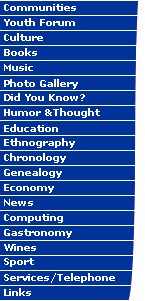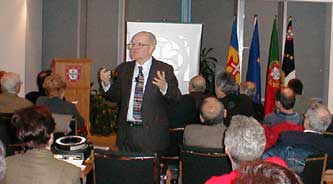




| The
Discovery of Canada by the Portuguese before the Birth of
Columbus A Conference by Dr. Manuel Luciano da Silva |
|
|

A conference by Dr. Manuel Luciano da Silva
held at the Consulate General of Portugal in Toronto on March
14, 2002 On March 14, 2002 at 5.30 pm a conference was held by Dr. Manuel Luciano da Silva at the Consulate General of Portugal in Toronto under the title of "The Discovery of Canada by The Portuguese before the Birth of Columbus". Before a full house, the conference unfolded round one of Dr. Silva's favourite themes, the so-called Portuguese Theory and Dighton Rock. He ended the conference with one of its more relevant components which pertains to Canada, namely that the Portuguese were in the regions of Newfoundland, Nova Scotia and Prince Edward Island long before Columbus' voyage of 1492. Basing himself on the Pizzigiano Map of 1424, Dr. Manuel Luciano da Silva retraced the route of Lusitanian mariners to the Antilhas and Ilhas Satanazes (Antilles and Devil Islands) and went on to demonstrate how the configuration of the 15th century map matches that of these regions. He briefly referred to the lexical legacy of the Portuguese language to North American native idioms before arriving at the origin of the word Canada. Taking the presence of the brothers Corte Real on the American east cost in the regions of Massuchusetts, New England and Maine as a given, he proposes that the word originated in the estates that the brothers' father, João Corte Real, owned in Tavira on the Portuguese mainland, that is Canada (or the place of the canes). In an accessible and humorous approach to the subject in hand, Dr. Manuel Luciano took his audience on an exciting adventure through time. He commenced by invoking the importance of the role of the Portuguese nation in opening up land and sea to the world, to which the modern day designation of the heart of the Atlantic as the Sargasso Sea bears witness. He then made reference to the great driving force behind the Portuguese maritime endeavour, Prince Henry the Navigator, calling him the pioneer and first proponent of the concept of Globalization and the importance of the research carried out at his nautical school at Sagres. Here Prince Henry gathered the best cartographers, astronomers and scientists of his time with the objective of projecting the presence of the Portuguese throughout the world. Here innovative navigational instruments and techniques were developed. These were then incorporated in the famous sea vessels of the Portuguese odyssey, the caravels. Among these innovations was the Latin sail (vela Latina,), the first to sail headlong into the wind, making navigation faster and more efficient. He mentioned the legacy of Bartholomew Diaz to posterity when he discovered that the sea currents of the northern hemisphere circulated clockwise while those of the southern hemisphere anti-clockwise. The apparent detour Vasco da Gama effected on his first voyage to India was in all likelihood a manoeuvre to take full of advantage of the flow of sea currents when doubling the Cape of Good Hope. He further pointed out that as far back as the 15th century, Portuguese navigators had knowledge of arc navigation. He then introduced us to, what he described as, his mistress of over 50 years, the controversial Dighton Rock. It seems Dr. Manuel Luciano first heard of Dighton Rock through his history teacher whilst a pupil at the *Oliveira de Azemeis High School. Years later, in 1949, himself, now an immigrant in the United States and a medical student at the University of New York, he travelled to the Taunton River in Berkley (on the outskirts of Boston) when he saw the Rock for the very first time. Placed upside down near the left bank of the river by the displacement of earth caused by the melting during the last ice age, the fact that the rock was covered by water for the better part of 20 hours a day, surfacing only during low tide, had protected it from vandalism and degradation. With a surface of 55 sq feet and weighing 40 tons, it was located in territory once part of the town of Dighton, now Berkley. Dighton Rock displayed different geomorphic features than those of other rock formations in the region. The first scholar to study the inscriptions on the rock in depth was Professor Edmund Delabarre. A psychologist and living in an era in which the study of calligraphy was held to be a major key to the personality, as from 1913 Delabarre spent a a considerable part of his time and moneys researching the Rock. But it was only in 1918, whilst examining a photograph of the Rock, that Delabarre detected an engraving dated 1511. Spurred on by his discovery, he began to investigate what possible 16th century explorers had been in the region and soon arrived at the names of the Corte Real brothers, Gaspar and Miguel. In 1920 he establishes the presence of seven letters of Miguel Corte Real's name on the Rock as well as the Portuguese national coat of arms in V form. (The Corte Real family, originally from Tavira in Portugal, later settled on the Island of Terceira in the Azorean archipelago. Its strategic position in the Atlantic allowed the brothers to set off to unknown lands in search of new codfish banks, as salted cod had become one of the staple diets and major currencies of the Portuguese.) Professor Delabarre's work in the development of the Portuguese Theory earned him the Cross of the Royal Order of Christ. On his death in 1945, Delabarre left a small piece of land (250 metres) next to Dighton Rock, the core of what was later to be Dighton Rock Park, and a small sum of money for the preservation of the Rock. Throughout the remainder of his life, Delabarre had organized several pilgrimages of Luso Americans to Dighton Rock. The Rock was to fascinate yet another scholar, Jose Damaso Fragoso. In 1948, he informed Dr. Da Silva he had effected a tracing of the rock and had discovered the Cross of the Royal Order of Christ, the only cross to have its extremities end in 45° angles. (The first drawings of the inscriptions on the Rock date back to Reverend John Danforth and James Winthrop in the 17th and 18th centuries respectively). In 1951, in an article published in the magazine "Portuguese World", João Fragoso describes the three Crosses of the Royal Order of Christ and triangular Portuguese coat of arms found on Dighton Rock. The Cross of the Royal Order of Christ, Order which had its headquarters in the town of Tomar, Portugal, accompanied all of the odyssey of the Portuguese Discoveries, on the sails of the caravels and stone crosses that marked the passing of Lusitanian pioneers throughout the world. The continuity of Delabrre's work was further secured by the founding of the Miguel Corte Real Memorial Society in 1951. Composed of Luso Americans, its aim was to acquire the lands contiguous to the Rock and perpetuate the memory of the Portuguese explorer, Miguel Corte Real. In 1952 the society bought 50 acres of land and the park was officially created by decree of the Massachusetts Senate in 1954. In 1963 the Rock was removed from the riverbed and relocated on the riverbank. The fragile wire fencing placed around it offered little or no protection from the acts of vandalism of visitors to the park. After a long and arduous struggle, Dr. Manuel Luciano managed to convince Massachussetts state authorities to attribute the sum of $50,000 for the construction of a pavilion in which to house the Rock and found a museum dedicated to the memory of the passing of the Native peoples, Vikings, Portuguese and other pioneers through the lands of North America. In his birthplace of Vale de Cambra, a small village near the Town of Oliveira de Azemeis in the north of Portugal, Dr. Manuel Luciano founded a Library cum Museum dedicated to the study and research of the Portuguese maritime accomplishments. Several times throughout the conference Dr. Manuel Luciano would pause to encourage man to pursue his dreams, invoking his own tenacity in his endeavour to prove to the world the veracity of the Portuguese Theory and of a past often forgotten by our own people. The Portuguese Consul in Toronto, Dr. João Perestrello, wound up the conference by thanking Dr. Manuel Luciano on behalf of all those present. Then followed a tribute to Dr. Manuel Luciano
by the Codfish Academy of Toronto in the form of a motion, proposing
that a scholarship be awarded to young luso academics who may
wish to take up this task, very much our own, very Lusitanian,
and which sets out to register the presence and contribution made
by our ancestors in the formation of modern day North America. |
|
